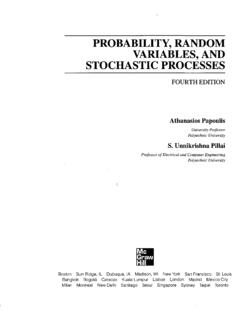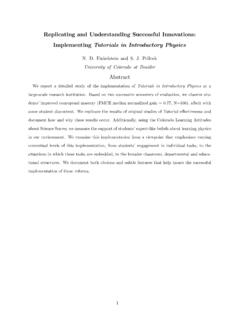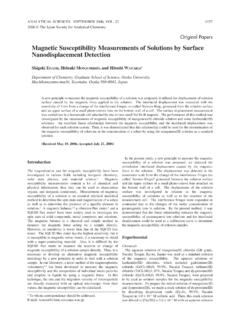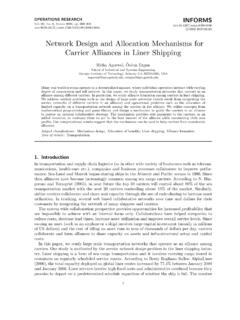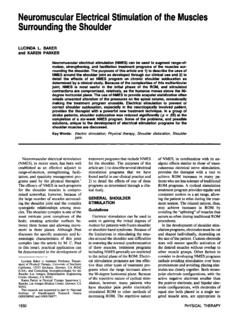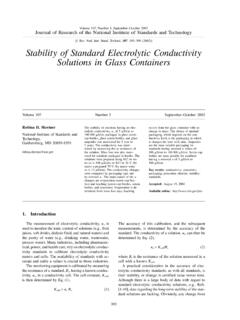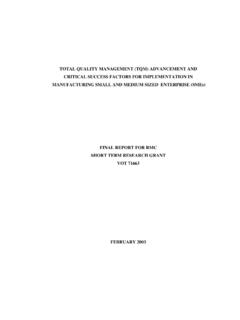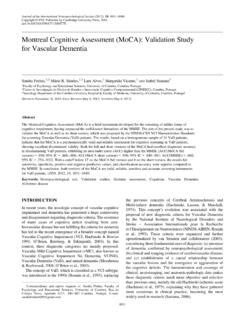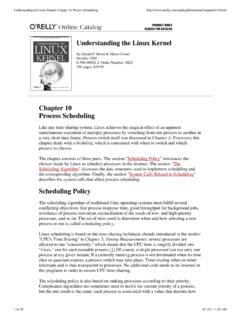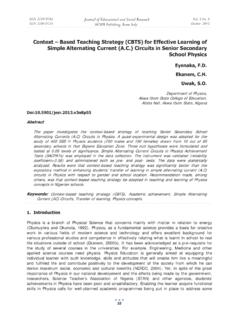Transcription of MULTIVARIATE DATA ANALYSIS - Semantic Scholar
1 SEVENTH EDITION MULTIVARIATE data ANALYSIS i .-*.'.. ' -4 A Global Perspective Joseph F. Hair, Jr. Kennesaw State University William C. Black Louisiana State University Barry J. Babin University of Southern Mississippi Rolph E. Anderson Drexel University Upper Saddle River Boston Columbus San Francisco New York Indianapolis London Toronto Sydney Singapore Tokyo Montreal Dubai Madrid Hong Kong Mexico City Munich Paris Amsterdam Cape Town CONTENTS Preface xxv About the Authors xxvii Chapter 1 Introduction: Methods and Model Building 1 What Is MULTIVARIATE ANALYSIS ?
2 3 MULTIVARIATE ANALYSIS in Statistical Terms 4 Some Basic Concepts of MULTIVARIATE ANALYSIS 4 The Variate 4 Measurement Scales 5 Measurement Error and MULTIVARIATE Measurement 7 Statistical Significance Versus Statistical Power 8 Types of Statistical Error and Statistical Power 9 Impacts on Statistical Power 9 Using Power with MULTIVARIATE Techniques 11 A Classification of MULTIVARIATE Techniques 11 Dependence Techniques 14 Interdependence Techniques 14 Types of MULTIVARIATE Techniques 15 Principal Components and Common Factor ANALYSIS 16 Multiple Regression 16 Multiple Discriminant ANALYSIS and Logistic Regression 16 Canonical Correlation 17 MULTIVARIATE ANALYSIS of Variance and Covariance 17 Conjoint ANALYSIS 18 Cluster ANALYSIS 18 Perceptual Mapping 19 Correspondence ANALYSIS 19 Structural Equation Modeling and Confirmatory Factor ANALYSIS 19 Guidelines for MULTIVARIATE Analyses and Interpretation 20 Establish Practical Significance as Well as Statistical Significance 20 Recognize That Sample
3 Size Affects All Results 21 Know Your data 21 Strive for Model Parsimony 21 Look at Your Errors 22 Validate Your Results 22 A Structured Approach to MULTIVARIATE Model Building 22 ix Stage 1: Define the Research Problem, Objectives, and MULTIVARIATE Technique to Be Used 23 Stage 2: Develop the ANALYSIS Plan 23 Stage 3: Evaluate the Assumptions Underlying the MULTIVARIATE Technique 23 Stage 4: Estimate the MULTIVARIATE Model and Assess Overall Model Fit 23 Stage 5: Interpret the Variate(s) 24 Stage 6: Validate the MULTIVARIATE Model 24 A Decision Flowchart 24 Databases 24 Primary Database 25 Other Databases 27 Organization of the Remaining Chapters 28 Section I: Understanding and Preparing For MULTIVARIATE ANALYSIS Section II: ANALYSIS Using Dependence Techniques 28 Section III: Interdependence Techniques 28 Section IV.
4 Structural Equations Modeling 28 Summary 28 Questions 30 Suggested Readings 30 References 30 SECTION I Understanding and Preparing For MULTIVARIATE ANALYSIS 31 Chapter 2 Cleaning and Transforming data 33 Introduction 36 Graphical Examination of the data 37 Univariate Profiling: Examining the Shape of the Distribution 38 Bivariate Profiling: Examining the Relationship Between Variables 39 Bivariate Profiling: Examining Group Differences 40 MULTIVARIATE Profiles 41 Missing data 42 The Impact of Missing data 42 A Simple Example of a Missing data ANALYSIS 43 A Four-Step Process for Identifying Missing data and Applying Remedies 44 An Illustration of Missing data Diagnosis with the Four-Step Process 54 Outliers 64 Detecting and Handling Outliers 65 An Illustrative Example of Analyzing Outliers 68 Testing the Assumptions of MULTIVARIATE ANALYSIS 70 Contents xi Assessing Individual Variables Versus the
5 Variate 70 Four Important Statistical Assumptions 71 data Transformations 77 An Illustration of Testing the Assumptions Underlying MULTIVARIATE ANALYSIS 79 Incorporating Nonmetric data with Dummy Variables 86 Summary 88 Questions 89 Suggested Readings 89 References 90 Chapter 3 Factor ANALYSIS 91 What Is Factor ANALYSIS ? 94 A Hypothetical Example of Factor ANALYSIS 95 Factor ANALYSIS Decision Process 96 Stage 1: Objectives of Factor ANALYSIS 96 Specifying the Unit of ANALYSIS 98 Achieving data Summarization Versus data Reduction 98 Variable Selection 99 Using Factor ANALYSIS with Other MULTIVARIATE Techniques 100 Stage 2: Designing a Factor ANALYSIS 100 Correlations Among Variables or Respondents 100 Variable Selection and Measurement Issues 101 Sample Size 102 Summary 102 Stage 3.
6 Assumptions in Factor ANALYSIS 103 Conceptual Issues 103 Statistical Issues 103 Summary 104 Stage 4: Deriving Factors and Assessing Overall Fit 105 Selecting the Factor Extraction Method 105 Criteria for the Number of Factors to Extract 108 Stage 5: interpreting the Factors 112 The Three Processes of Factor Interpretation 112 Rotation of Factors 113 Judging the Significance of Factor Loadings 116 interpreting a Factor Matrix 118 Stage 6: Validation of Factor ANALYSIS 122 Use of a Confirmatory Perspective 122 Assessing Factor Structure Stability 122 Detecting Influential Observations 123 Stage 7: Additional Uses of Factor ANALYSIS Results 123 Selecting Surrogate Variables for Subsequent ANALYSIS 123 Creating Summated Scales 124 Computing Factor Scores 127 Selecting Among the Three Methods 128 An Illustrative Example 129 Stage 1: Objectives of Factor ANALYSIS 129 Stage 2: Designing a Factor ANALYSIS 129 Stage 3.
7 Assumptions in Factor ANALYSIS 129 Component Factor ANALYSIS : Stages 4 Through 7 132 Common Factor ANALYSIS : Stages 4 and 5 144 A Managerial Overview of the Results 146 Summary 148 Questions 150 Suggested Readings 150 References 150 SECTION II ANALYSIS Using Dependence Techniques 153 Chapter 4 Simple and Multiple Regression 155 What Is Multiple Regression ANALYSIS ? 161 An Example of Simple and Multiple Regression 162 Prediction Using a Single Independent Variable: Simple Regression 162 Prediction Using Several Independent Variables: Multiple Regression 165 Summary 167 A Decision Process for Multiple Regression ANALYSIS 167 Stage 1: Objectives of Multiple Regression 169 Research Problems Appropriate for Multiple Regression 169 Specifying a Statistical Relationship 171 Selection of Dependent and Independent Variables 171 Stage 2.
8 Research Design of a Multiple Regression ANALYSIS 173 Sample Size 174 Creating Additional Variables 176 Stage 3: Assumptions in Multiple Regression ANALYSIS 181 Assessing Individual Variables Versus the Variate 182 Methods of Diagnosis 183 Linearity of the Phenomenon 183 Constant Variance of the Error Term 185 Independence of the Error Terms 185 Normality of the Error Term Distribution 185 Summary 186 Stage 4: Estimating the Regression Model and Assessing Overall Model Fit 186 Selecting an Estimation Technique 186 Testing the Regression Variate for Meeting the Regression Assumptions 191 Contents xiii Examining the Statistical Significance of Our Model 192 Identifying Influential Observations 194 Stage 5: interpreting the Regression Variate 197 Using the Regression Coefficients 197 Assessing Multicollinearity 200 Stage 6.
9 Validation of the Results 206 Additional or Split Samples 206 Calculating the PRESS Statistic 206 Comparing Regression Models 206 Forecasting with the Model 207 Illustration of a Regression ANALYSIS 207 Stage 1: Objectives of Multiple Regression 207 Stage 2: Research Design of a Multiple Regression ANALYSIS 208 Stage 3: Assumptions in Multiple Regression ANALYSIS 208 Stage 4: Estimating the Regression Model and Assessing Overall Model Fit 208 Stage 5: interpreting the Regression Variate 223 Stage 6: Validating the Results 226 Evaluating Alternative Regression Models 227 A Managerial Overview of the Results 231 Summary 231 Questions 234 Suggested Readings 234 References 234 Chapter 5 Canonical Correlation 235 What Is Canonical Correlation?
10 237 Hypothetical Example of
